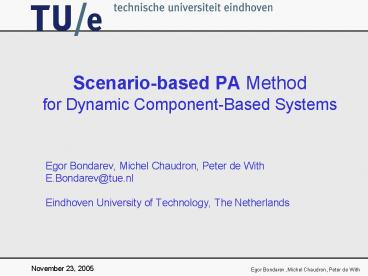Scenario-based PA Method for Dynamic Component-Based Systems - PowerPoint PPT Presentation
Title:
Scenario-based PA Method for Dynamic Component-Based Systems
Description:
Scenario-based PA Method for Dynamic Component-Based Systems Egor Bondarev, Michel Chaudron, Peter de With E.Bondarev_at_tue.nl Eindhoven University of Technology, The ... – PowerPoint PPT presentation
Number of Views:104
Avg rating:3.0/5.0
Title: Scenario-based PA Method for Dynamic Component-Based Systems
1
Scenario-based PA Method for Dynamic
Component-Based Systems
- Egor Bondarev, Michel Chaudron, Peter de With
- E.Bondarev_at_tue.nl
- Eindhoven University of Technology, The
Netherlands
2
Problem Statement
- - To accurately predict the performance
attributes - - of software component-based systems
- - built on multiprocessor architectures
- Performance attributes
- Timing behaviour,
- Processor usage,
- Memory consumption,
- Bus load
3
Example Problem Car Navigation System (CNS)
4
CNS Architectural Alternatives
1. Predict performance for every alternative 2.
Find optimal alternatives in terms of Resource
usage Performance Robustness
5
Proposed Solution
Based on the following concepts
- Models for both software- and hardware
components. - Scenarios-based evaluation
- The designer can focus on critical run-time
configurations. - Allows trade-off between modeling effort and
accuracy. - Simulation of scenarios schedulability analysis
6
Performance Prediction Approach (2/2)
Input
Application requirements
7
Behaviour and Resource Models
BehavourModel_MPEG4Decoder_Component
behaviour operation IDecode.decodeFrame()
calls IBufferAccess.getElement()
passedBits 0 returnedBits 1024
synchronous TRUE
numberOfIterations 1 calls
IBufferAccess.storeElement()
passedBits 1024 returnedBits 1
synchronous TRUE
numberOfIterations 1
ResourceModel_MPEG4Decoder_Component resource
use operation IDecode.decodeFrame()
cpu claim max 1E7 cycles
(reference processor) aver 1E5
cycles (reference processor) min
1E4 cycles (reference processor) mem
claim 10 KB mem release 3 KB
IDecode
IBufferAccess
getElement()
decodeFrame()
storeElement()
8
Composition of Software Components
9
Composition of Hardware Components
- Performance model specifies IP processing
capabilities. - For processing core ? frequency rate and
scheduling policy - For memory ? a memory size and addressing type
- For bus ? bit-size, frequency and arbitration
policy
10
SW / HW Mapping
11
Application Scenario Modelling
- A scenario model defines
- environmental events or system interrupts
- application level stimuli (task triggers)
- for a specific hw/sw-configuration (composition
structure)
12
Composing the Models
- The generated task specifies
- sequence of constituent method invocations
- period, deadline, priority, synchronization
constraints
Service_A
Operation_A
13
Scenario Simulation Analysis
- Simulation or Schedulability analysis are
performed with scheduling algorithms deployed on
the target OS (RMA, EDF, CBS) - Simulation results in task latencies, number of
missed deadlines, CPU, memory and bus utilization
Simulation time
Bus load
Mem load
Simulation time
Simulation time
14
Not mentioned Facilities and Benefits
- Modelling of parameter-dependent behaviour and
resource usage - Multiple-platform resource models
- Task synchronization aspects can be modeled
- Component mapping on multiprocessor architecture
- Multidimensional design space exploration
- robusteness vs cost, memory_load vs cpu_load, etc
15
Framework Deployment Issues
- We have developed a tool chain supporting the
design activities - We have validated the prediction approach by
MPEG4 Decoder case study - prediction accuracy of task latencies is gt 90
Real-Time Prediction Framework































